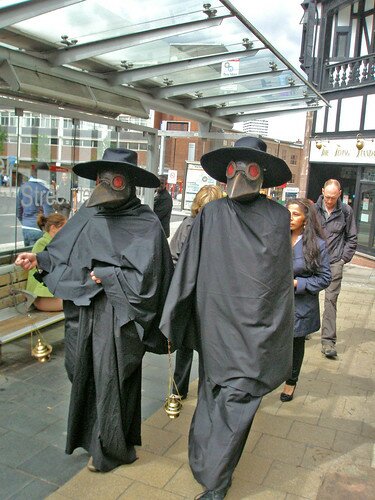About two weeks ago (as you read this column), just as the coronavirus lockdown was beginning, I decided I needed a break from anything too contemporary, and to watch something “historical” for entertainment. I picked re-watching World Without End, the mini-series based on the novel by Kenneth Follett.
I wound up laughing at myself. It had been almost ten years since I had read the novel, and seven or eight since I watched the series. I had forgotten that a large part of the story deals with how the principal characters dealt with the Bubonic Plague of the mid 1300s.
World Without End is the second novel in Follett’s trilogy that begins with Pillars of the Earth and concludes with Column of Fire. All are set in the fictitious English town of Kingsbridge, located in the equally fictitious County of Shiring. The trilogy shows the evolution of the town, and the fates of families within it, from the early Twelfth Century through the beginning of the Seventeenth. The second novel takes place during the reign of Edward III, which saw the beginning of the Hundred Years’ War with France and the Bubonic Plague.
There were a number of names for the Plague. The one I have used derives from the large blisters, or “bubons” that broke out on its victims. Another name was “the Black Death”. According to Follett, the 14th Century English called it “the Mortality.” Historians are divided on how much of Europe’s population fell victim to it. Most say one third, but some claim it was closer to a half.
The Black Death (which is still around, but dormant) is spread by lice that breed on mice and rats. In the 14th Century, it spread from Asia to Europe through trading caravans and vessels. Its victims included Edward III’s favorite daughter, who was on her way to her wedding to the crown prince of Castile when the Plague took her. Not surprisingly, the disease wrecked its greatest toll in cities and towns. But no village was safe.
While watching the series, and remembering the novel, I was struck by the similarities and differences between the Bubonic Plague and the present coronavirus threat. The differences are easy to spot. Medical practices at the time were primitive, often ignorant, and at times barbaric, by our standards. They were performed by friars, nuns, and village “herb women”, who were suspected of witchcraft but knew more than many of the university-trained physicians of the time.
The similarities to today are all the same remarkable. One was the dedication of healthcare workers, whether drawn from the religious orders or from the local communities. These tended the sick, encouraged the wearing of linen masks over their faces, and supervised the grisly work of burying the dead so that Plague and infection did not spread further. We are seeing something akin to that now.
Another was the realization that, in the midst of Plague, life had to go on somehow. Some were reckless in their pursuit of power or gain regardless of the pestilence that stalked the land. Others were more practical and frequently more selfless. Someone had to raise and harvest the crops, tend to the livestock, cook the food, wash the clothes, and look after the children, including the many orphans left by the Black Death. Somehow, all of these things got done.
Today, even among the exhortations to “stay home” and the governmental orders that everything should be “buttoned up” except for “essential services”, it’s easy to lose sight of how many services are essential.
Power workers, communications systems workers, fuel and food delivery workers, and food packagers, not to mention firefighters, law enforcement personnel, and healthcare workers, cannot, for the most part, “stay home”. If they do, the rest of us will die, if not of coronavirus, of exposure or starvation. That’s the brutal truth of it.
Nowadays, many tasks can be performed remotely. Meetings can go forward by audio or video teleconference. Even court hearings and board meetings can be handled remotely. But someone, somewhere, is keeping the lights on so that can happen.
We will get through this. There will be an end to the coronavirus just as there was, as related in the story, an end to the Black Death.
We just need to keep our heads in the meantime.
****
Photo by 70023venus2009 



Comments